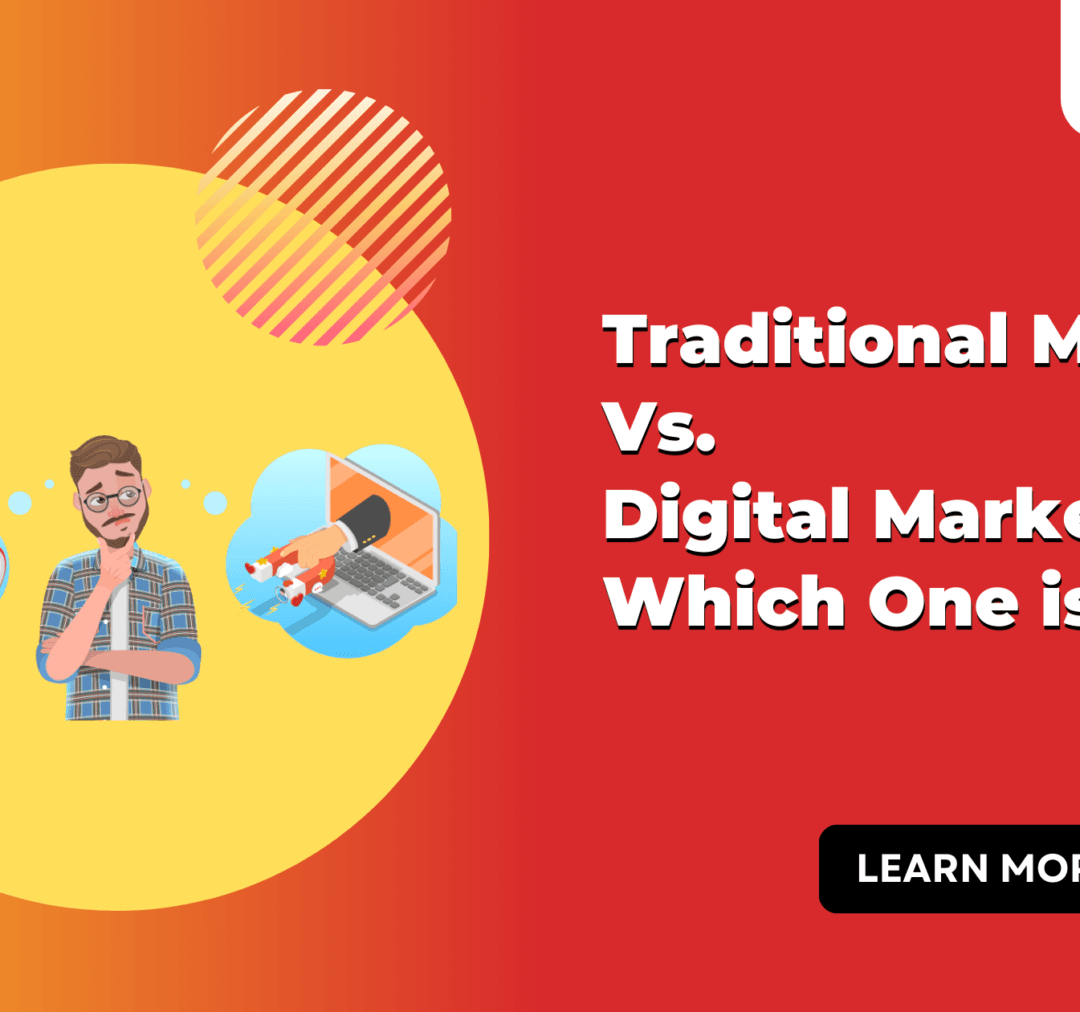In today’s rapidly evolving business world, the debate between digital marketing vs traditional marketing continues to spark curiosity among marketers, entrepreneurs, and business owners. Both approaches have their merits, but the crucial question remains: Which one is better for your business?
To truly understand the difference between traditional marketing and digital marketing, it’s essential to explore each method’s characteristics, benefits, and limitations. This blog will guide you through both marketing strategies and help you determine which approach fits your business needs in 2024.
What is Traditional Marketing?
Traditional marketing refers to any marketing campaign that doesn’t involve digital platforms. Traditional marketing has been around for decades, providing a tangible and direct way to reach customers. It focuses on mass communication, aiming to promote products and services to a wide audience through offline methods. This includes traditional marketing methods such as:
- TV and Radio Ads: One of the oldest forms of marketing, reaching a broad audience.
- Print Ads: Newspapers, magazines, flyers, and brochures are common mediums.
- Billboards and Outdoor Advertising: Seen in high-traffic areas to attract attention.
- Direct Mail Marketing: Sending physical mail to potential customers.
- Telemarketing: Direct phone calls to target audiences.
What is Digital Marketing?

In contrast, digital marketing encompasses all marketing efforts conducted through the internet and digital devices. Digital marketing is about using the power of the internet to promote a brand and engage with customers in a more personalized way. Key channels include:
- Search Engine Optimization (SEO): Optimizing a website to rank higher on search engine result pages (SERPs).
- Social Media Marketing: To communicate with audiences, social media marketers use platforms like Facebook, Instagram, LinkedIn, and Twitter.
- Pay-Per-Click (PPC) Advertising: Paid ads on platforms such as Google, driving targeted traffic to websites.
- Email Marketing: Directly reaching customers via email campaigns.
- Content Marketing: Creating valuable content (blogs, videos, etc.) to attract potential customers.
Traditional Marketing vs. Digital Marketing
When comparing marketing digital vs traditional, several key differences emerge that highlight the strengths and limitations of each approach:
1. Audience Reach
- Traditional Marketing: Effective for targeting local or regional audiences but lacks precise targeting capabilities. Mass communication methods may not always guarantee that the right audience is reached.
- Digital Marketing: Offers precise targeting through data-driven strategies. Marketers can segment audiences by age, location, interests, and behavior, making it ideal for reaching niche markets.
2. Cost-Effectiveness
- Traditional Marketing: Generally more expensive due to the high costs of TV ads, radio spots, and print media.
- Digital Marketing: A cost-effective solution. With options like social media and SEO, businesses can start small and scale their efforts as they grow. The affordability of digital marketing has made it accessible for businesses of all sizes.
3. Measurable Results
- Traditional Marketing: Tracking success is challenging, and results are often based on assumptions or estimates. For example, how do you measure the exact impact of a billboard ad?
- Digital Marketing: Offers real-time data and analytics. Tools like Google Analytics and social media insights provide detailed metrics on engagement, clicks, conversions, and ROI, allowing businesses to adjust strategies for better performance.
4. Interaction and Engagement
- Traditional Marketing: One-way communication. Customers receive the message but have limited means to interact with the brand directly.
- Digital Marketing: Businesses can communicate with customers on social media sites by leaving comments, liking, sharing, and sending direct messages.
5. Flexibility
- Traditional Marketing: Long campaign lead times reduce adaptability. It is impossible to modify an advertisement once it has been printed or aired.
- Digital Marketing: Highly flexible, allowing quick adjustments to campaigns based on real-time data. If a social media post isn’t performing well, it can be altered instantly.
Pros of Traditional Marketing vs Digital Marketing
| Traditional Marketing | Digital Marketing |
|---|---|
| Pros: | Pros: |
| Tangible (e.g., print ads) | Cost-effective |
| Established credibility | Real-time data and analytics |
| Broad audience reach | Highly targeted advertising |
| Familiar to older generations | Interactive and engaging |
| Long-lasting exposure (billboards, etc.) | Flexible and adaptable |
Cons of Traditional Marketing vs Digital Marketing
| Cons of Traditional Marketing | Cons of Digital Marketing |
|---|---|
| – High costs | – Requires digital literacy |
| – Difficult to measure results | – Highly competitive |
| – Limited interaction with the audience | – Can be time-consuming |
| – Less flexibility for immediate changes | – Rapidly changing trends |
| – Audience targeting is less precise | – Requires constant optimization |
The Future of Digital Marketing
Looking ahead, digital marketing is set to continue its reign as the dominant force in the marketing landscape. Why? Because it’s adaptable, allows for real-time engagement, and offers unmatched cost-effectiveness. With businesses and consumers spending more time online, digital strategies are proving essential for growth and relevance.
Here are a few key reasons why digital marketing is the future:
- Targeted Reach: Unlike traditional methods, digital marketing lets you reach specific audiences based on behavior, interests, and demographics.
- Real-Time Analytics: Track campaigns in real-time, measure performance, and make data-driven adjustments to maximize effectiveness.
- Cost-Effective: From SEO to social media ads, digital marketing offers options that are budget-friendly, making it accessible for businesses of all sizes.
- Higher Engagement: Through social media and personalized content, digital marketing fosters direct interaction, encouraging more meaningful engagement with customers.
- Scalability: Start small and scale as you grow. Digital marketing allows for flexibility, letting businesses expand their campaigns with ease.
- Global Reach: Break geographical barriers by reaching audiences worldwide with just a click.
The Future of Traditional Marketing
While traditional marketing still holds value in certain industries, its future looks increasingly limited compared to the rapid rise of digital. Traditional methods, such as TV ads, billboards, and print media, face significant challenges:
- High Costs: Traditional marketing can be expensive, with little flexibility for small businesses to compete with big players.
- Limited Targeting: Unlike digital platforms, traditional marketing lacks precise audience targeting, resulting in wasted ad spend.
- Difficult to Measure: Measuring the ROI of a billboard or print ad is challenging, making it hard to track the true effectiveness of a campaign.
- One-Way Communication: Traditional marketing is a one-way street, offering no real-time engagement or interaction with audiences.
- Declining Reach: As more consumers turn to digital platforms for information, traditional media’s reach is shrinking, especially among younger audiences.








